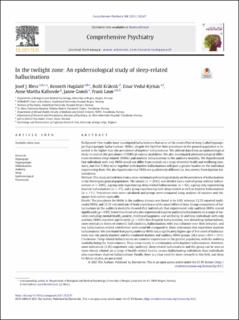| dc.description.abstract | Background
Few studies have investigated hallucinations that occur at the onset/offset of sleep (called hypnagogic/hypnopompic hallucinations; HHHs), despite the fact that their prevalence in the general population is reported to be higher than the prevalence of daytime hallucinations. We utilized data from an epidemiological study to explore the prevalence of HHHs in various modalities. We also investigated phenomenological differences between sleep-related (HHHs) and daytime hallucinations in the auditory modality. We hypothesized that individuals with only HHHs would not differ from controls on a range of mental health and wellbeing measures, but that if they occur together with daytime hallucinations will pose a greater burden on the individual experiencing them. We also hypothesize that HHHs are qualitatively different (i.e. less severe) from daytime hallucinations.
Methods
This study utilized data from a cross-sectional epidemiological study on the prevalence of hallucinations in the Norwegian general population. The sample (n = 2533) was divided into a control group without hallucinations (n = 2303), a group only experiencing sleep-related hallucinations (n = 62), a group only experiencing daytime hallucinations (n = 57), and a group experiencing both sleep-related as well as daytime hallucinations (n = 111). Prevalence rates were calculated and groups were compared using analyses of variance and chi-square tests where applicable.
Results
The prevalence for HHHs in the auditory domain was found to be 6.8%, whereas 12.3% reported multimodal HHHs, and 32.2% indicated out-of-body experiences at the onset/offset of sleep. Group comparisons of hallucinations in the auditory modality showed that individuals that experienced only auditory HHHs scored significantly (p < 0.05) lower than those who also experienced daytime auditory hallucinations on a range of variables including mental health, anxiety, childhood happiness, and wellbeing. In addition, individuals with only auditory HHHs reported significantly (p < 0.05) less frequent hallucinations, less disturbing hallucinations, more neutral (in terms of content) hallucinations, hallucinations with less influence over their behavior, and less hallucination-related interference with social life compared to those individuals that experience daytime hallucinations. We also found that purely auditory HHHs had a significantly higher age of first onset of hallucinations than the purely daytime and the combined daytime and auditory HHHs groups (28.2 years>20.9 > 19.1).
Conclusions
Sleep-related hallucinations are common experiences in the general population, with the auditory modality being the least common. They occur mostly in combination with daytime hallucinations. However, some individuals (2.4%) experience only (auditory) sleep-related hallucinations and this group can be seen as more closely related, on a range of health-related factors, to non-hallucinating individuals than individuals who experience daytime hallucinations. Finally, there is a clear need for more research in this field, and ideas for future studies are presented. | en_US |

